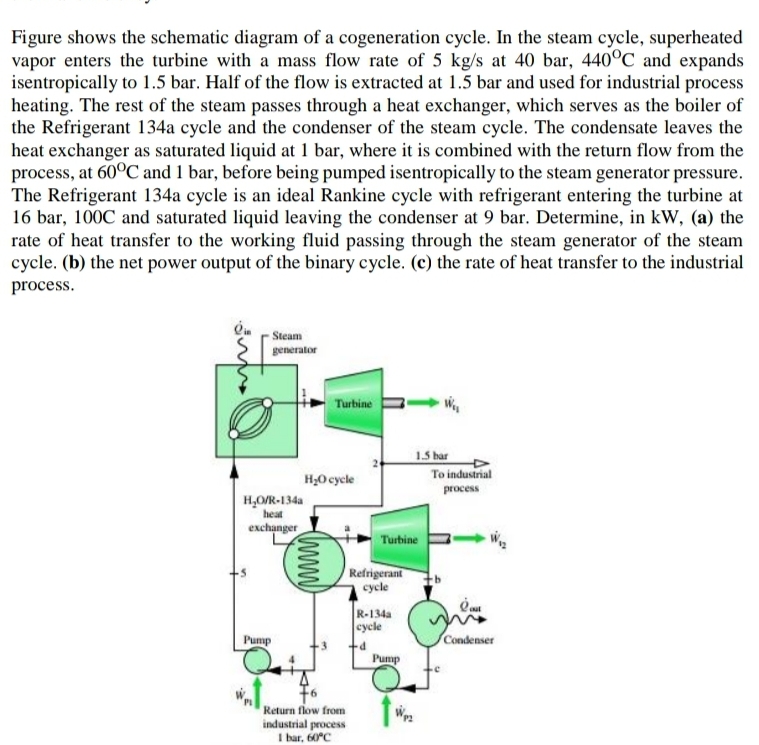16 bar, 100C and saturated liquid leaving the condenser at 9 bar. Determine, in kW, (a) the rate of heat transfer to the working fluid passing through the steam generator of the steam cycle. (b) the net power output of the binary cycle. (c) the rate of heat transfer to the industrial process.
16 bar, 100C and saturated liquid leaving the condenser at 9 bar. Determine, in kW, (a) the rate of heat transfer to the working fluid passing through the steam generator of the steam cycle. (b) the net power output of the binary cycle. (c) the rate of heat transfer to the industrial process.
Elements Of Electromagnetics
7th Edition
ISBN:9780190698614
Author:Sadiku, Matthew N. O.
Publisher:Sadiku, Matthew N. O.
ChapterMA: Math Assessment
Section: Chapter Questions
Problem 1.1MA
Related questions
Question
Please answer a,b,c. Badly needed. Thank you.

Transcribed Image Text:Figure shows the schematic diagram of a cogeneration cycle. In the steam cycle, superheated
vapor enters the turbine with a mass flow rate of 5 kg/s at 40 bar, 440°C and expands
isentropically to 1.5 bar. Half of the flow is extracted at 1.5 bar and used for industrial process
heating. The rest of the steam passes through a heat exchanger, which serves as the boiler of
the Refrigerant 134a cycle and the condenser of the steam cycle. The condensate leaves the
heat exchanger as saturated liquid at 1 bar, where it is combined with the return flow from the
process, at 60°C and 1 bar, before being pumped isentropically to the steam generator pressure.
The Refrigerant 134a cycle is an ideal Rankine cycle with refrigerant entering the turbine at
16 bar, 100C and saturated liquid leaving the condenser at 9 bar. Determine, in kW, (a) the
rate of heat transfer to the working fluid passing through the steam generator of the steam
cycle. (b) the net power output of the binary cycle. (c) the rate of heat transfer to the industrial
process.
-Steam
generator
Turbine
15 har
To industrial
H,0 cycle
process
H,O/R-134a
heat
exchanger
Turbine
Refrigerant
cycle
R-134a
cycle
Pump
Condenser
Pump
Return flow from
industrial process
I har, 60°C
Expert Solution
This question has been solved!
Explore an expertly crafted, step-by-step solution for a thorough understanding of key concepts.
Step by step
Solved in 2 steps with 2 images

Knowledge Booster
Learn more about
Need a deep-dive on the concept behind this application? Look no further. Learn more about this topic, mechanical-engineering and related others by exploring similar questions and additional content below.Recommended textbooks for you

Elements Of Electromagnetics
Mechanical Engineering
ISBN:
9780190698614
Author:
Sadiku, Matthew N. O.
Publisher:
Oxford University Press

Mechanics of Materials (10th Edition)
Mechanical Engineering
ISBN:
9780134319650
Author:
Russell C. Hibbeler
Publisher:
PEARSON

Thermodynamics: An Engineering Approach
Mechanical Engineering
ISBN:
9781259822674
Author:
Yunus A. Cengel Dr., Michael A. Boles
Publisher:
McGraw-Hill Education

Elements Of Electromagnetics
Mechanical Engineering
ISBN:
9780190698614
Author:
Sadiku, Matthew N. O.
Publisher:
Oxford University Press

Mechanics of Materials (10th Edition)
Mechanical Engineering
ISBN:
9780134319650
Author:
Russell C. Hibbeler
Publisher:
PEARSON

Thermodynamics: An Engineering Approach
Mechanical Engineering
ISBN:
9781259822674
Author:
Yunus A. Cengel Dr., Michael A. Boles
Publisher:
McGraw-Hill Education

Control Systems Engineering
Mechanical Engineering
ISBN:
9781118170519
Author:
Norman S. Nise
Publisher:
WILEY

Mechanics of Materials (MindTap Course List)
Mechanical Engineering
ISBN:
9781337093347
Author:
Barry J. Goodno, James M. Gere
Publisher:
Cengage Learning

Engineering Mechanics: Statics
Mechanical Engineering
ISBN:
9781118807330
Author:
James L. Meriam, L. G. Kraige, J. N. Bolton
Publisher:
WILEY